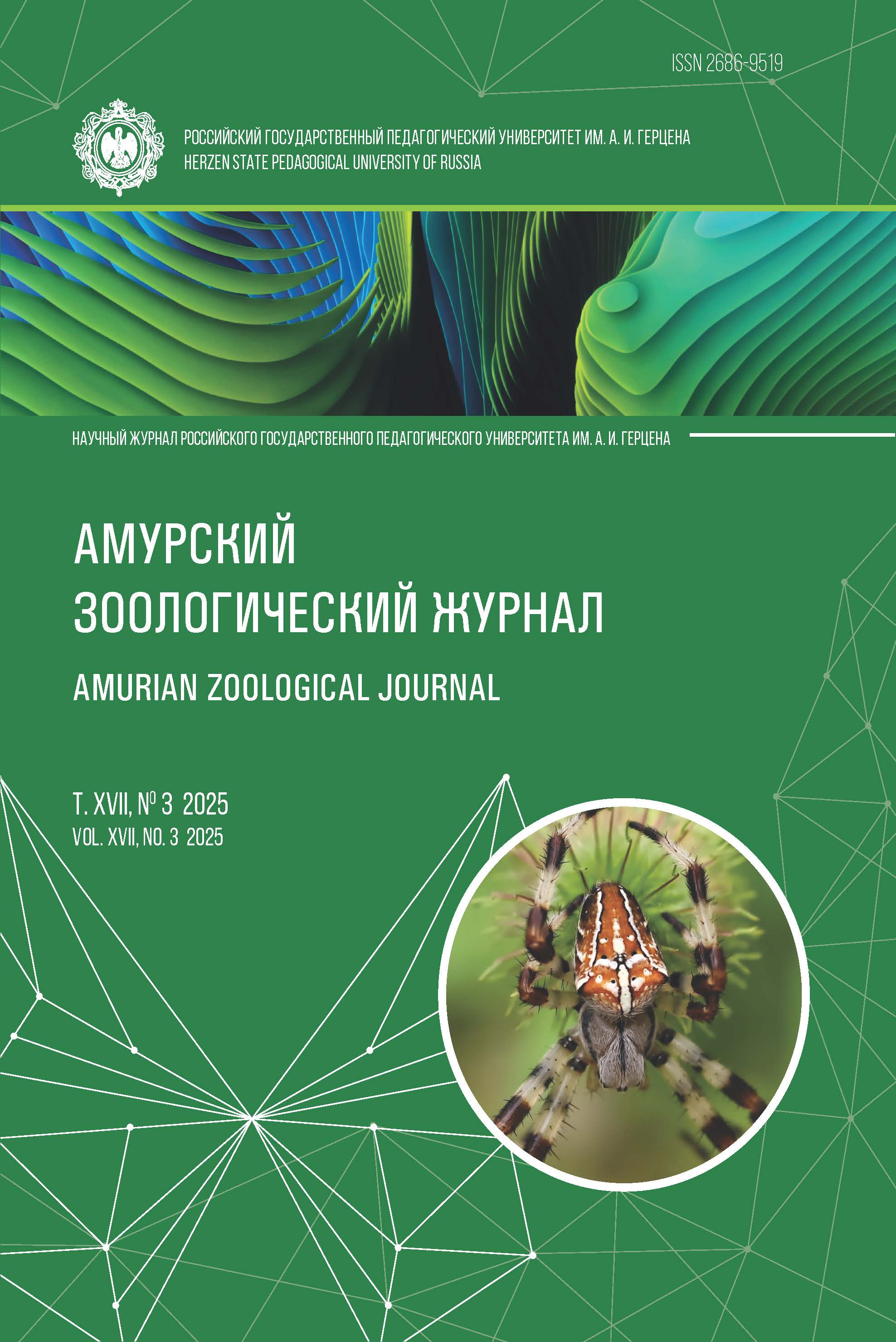Герпетологические наблюдения на острове Кайо-Круз
DOI:
https://doi.org/10.33910/2686-9519-2025-17-3-476-480Ключевые слова:
Куба, архипелаг Сабана-Камагуэй, Кайо-Круз, герпетофауна, пресмыкающиесяАннотация
Герпетофауна острова Кайо-Круз архипелага Сабана-Камагуэй, расположенного у северного побережья Кубы, включает семь видов наземных пресмыкающихся (Ameiva auberi orlandoi, Anolis jubar santamariae, Anolis porcatus porcatus, Cyclura nubila nubila, Leiocephalus stictigaster septentrionalis, Hemidactylus mabouia,Cubophis cantherigerus cantherigerus) и три вида морских черепах (Chelonia mydas, Caretta caretta, Eretmochelys imbricata). Земноводные на острове отсутствуют. Подтверждено присутствие на острове амейвы Pholidoscelis auberi, уточнена подвидовая принадлежность Anolis jubar, впервые для острова зарегистрирован Hemidactylus mabouia. Третий вид анолисов, Anolis sagrei, был указан ошибочно, вероятно, на основании неверного определения самок другого вида — Anolis jubar.
Библиографические ссылки
Bondarenko, D. A. (1994) Rasprostranenie i plotnost’ naseleniya sredneaziatskoj cherepakhi v Tsentral’nykh Kyzylkumakh (Uzbekistan) [Distribution and population density of Horsfield’s tortoise in central Kizil-kum (Usbekistan)]. Byulleten’ Moskovskogo obshchestva ispytatelej prirody. Otdel biologicheskij — Bulletin of Moscow Society of Naturalists. Biological Series, vol. 99, no. 1, pp. 22–27. (In Russian)
Bondarenko, D. A., Ergashev, U. H. (2022) Presmykayushchiesya pustynnykh ravnin Yugo-Zapadnogo Tadzhikistana: prostranstvennoe raspredelenie, plotnost’ naseleniya i struktura soobshchestv [Reptiles of the Southwestern Tajikistan desert plains: Spatial distribution, population density and communities structure]. Sovremennaya gerpetologiya — Current Studies in Herpetology, vol. 22, no. 1-2, pp. 17–39. https://doi.org/10.18500/1814-6090-2022-22-1-2-17-39 (In Russian)
Borroto-Páez, R., Bosch, R. A., Fabres, B. A., Garsía, O. A. (2015) Introduced amphibians and reptiles in the Cuban archipelago. Herpetological Conservation and Biology, vol. 10, no. 3, pp. 985–1012. (In English)
Claro, R., Reshetnikov, Yu. S., Alcolado, P. M. (2001) Physical attributes of Coastal Cuba. In: R. Claro, K. C. Lindeman, L. R. Parenti (eds.). Ecology of the marine fishes of Cuba. Washington: Smithsonian Institution Press, pp. 1–20. (In English)
Estrada, A. R. (2012) The Cuban Archipelago. Bulletin of the Florida Museum of Natural History, vol. 51, no. 2, pp. 113–125. https://doi.org/10.58782/flmnh.bjvk7571 (In English)
Galford, G. L., Fernandez, M., Roman, J. et al. (2018) Cuban land use and conservation, from rainforests to coral reefs. Bulletin of Marine Science, vol. 94, no. 2, pp. 171–191. https://doi.org/10.5343/bms.2017.1026 (In English)
Gavián, F. M., Andreu, G. N., Ricardo, J. A. et al. (2011) Principales áreas de anidación de las tortugas marinas en el archipiélago cubano [Principal areas of marine turtle nesting activity in the Cuban Archiapelago]. Cub@: Medio Ambiente y Desarrollo; Revista electrónica de la Agencia de Medio Ambiente, vol. 11, no. 20, pp. 1–7. (In Spanish)
Schwartz, A. (1968) The Cuban lizards of the Anolis homolechis complex. Tulane Studies in Zoology, vol. 14, no. 4, pp. 140–184. https://doi.org/10.5962/BHL.PART.29853 (In English)
Загрузки
Опубликован
Выпуск
Раздел
Лицензия
Copyright (c) 2025 Мильто Константин Дмитриевич

Это произведение доступно по лицензии Creative Commons «Attribution-NonCommercial» («Атрибуция — Некоммерческое использование») 4.0 Всемирная.
Авторы предоставляют материалы на условиях публичной оферты и лицензии CC BY 4.0. Эта лицензия позволяет неограниченному кругу лиц копировать и распространять материал на любом носителе и в любом формате в любых целях, делать ремиксы, видоизменять, и создавать новое, опираясь на этот материал в любых целях, включая коммерческие.
Данная лицензия сохраняет за автором права на статью, но разрешает другим свободно распространять, использовать и адаптировать работу при обязательном условии указания авторства. Пользователи должны предоставить корректную ссылку на оригинальную публикацию в нашем журнале, указать имена авторов и отметить факт внесения изменений (если таковые были).
Авторские права сохраняются за авторами. Лицензия CC BY 4.0 не передает права третьим лицам, а лишь предоставляет пользователям заранее данное разрешение на использование при соблюдении условия атрибуции. Любое использование будет происходить на условиях этой лицензии. Право на номер журнала как составное произведение принадлежит издателю.







